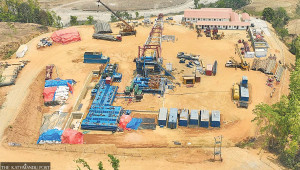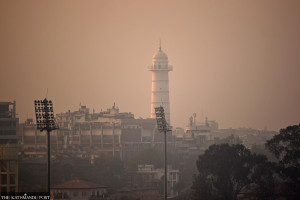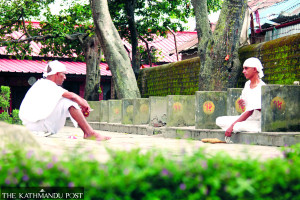Columns
The state of Nepali resistance
The mere evocation of the abstract power of the state and the glory of the fighters in history cannot guarantee the power of resistance..jpg&w=900&height=601)
Abhi Subedi
We can understand more by taking our own example. We test the power of the Nepali state's resistance by recalling certain historical moments. When it comes to the border issue with neighbours, we evoke the Anglo-Nepali war that ended by signing an agreement with the British Raj in India. Though Nepal lost quite a chunk of territory in that war, the names of some heroes, the fighters some of whom are placed in the pantheon of national heroes or rastriya bibhuti, are naturally recalled. Historians differ as to the dates and efforts of the ruling bodies to foster a sense of nationalism. I do not want to go into this subject. The monument of that power was erected in the architectural construction called Dharahara.
It would be appropriate to recall the historicity of that tower and to relate it to the psyche of resistance. Queen Lalittripurasundari was sensitive to the humiliation suffered by the Nepali state in the treaty of Sugauli in 1816. For that reason, she gave Mukhtiar Bhimsen Thapa permission to build the Dharahara believing that it was needed to alleviate the pain of humiliation. Dharahara was built in 1826 but was destroyed by the major earthquake of 1934, and was restored with the same spirit with which it was built.
The tower represents a historicity of Nepali resistance. To cite from my earlier article, ‘The senior architect Sudarsan Raj Tiwari calls Dharahara—hara being the evocation of Shiva—the monumental structure that was built to make up for the humiliation suffered by Nepal in the Sugauli Treaty in his essay "Two Nepalese Monuments"’ (The Kathmandu Post, 21 Feb 2016). Tiwari was indicating at the remarks of Hector Oldfield, a British surgeon at the Kathmandu Residency from 1850-1873. That Oldfield was 'astonished' by the feats of its architecture, as seen in his remarkable memoirs published in his illustrated book 'Sketches from Nepal' is the reason for evoking the power of the tower. But Oldfield called the tower 'Bhimsen's Folly.'
That the Nepali state has the strong power of resistance is mentioned in different writings and interpretations. But to believe that the Nepali state has the power to resist serious challenges is a natural phenomenon talking in terms of the response of the citizenry. That is not exclusive to Nepal; it is a common process everywhere. But is the modern Nepali state capable of maintaining its power of resistance in the face of natural calamities, border problems, educational crises, medical anarchy, and the corrosive impact of planning gone awry? The increasing state of open corruption in every front involving deals and projects, and most dangerously the apathy of the state towards education—the hostility of the state towards books to dampen the reading enthusiasm and culture—are definitely making the resistance power of the state weaker by the day.
The result of the above factors is that the state has become weaker to resist the problems. Besides the familiar problems that the state should brace for resisting, new unforeseen challenges naturally call for a greater state of preparedness. To take one burning example, we are now like everybody else around the world alarmed by the scourge of the novel coronavirus that requires a great concerted kind of resistance to tackle it. We only hope that such a problem will not arise. But if it did, at all the current state of corruption and mismanagement would not hamper our efforts.
Resistance is a theoretical concept that is discussed by scholars and philosophers whose names cannot be mentioned here. But resistance theories are used in the context of identities, injustice, gender and racial discriminations and marginalisation. Resistance evokes the power and practice of rebellion. The underlying spirit of the subaltern studies always fascinates me. When Antonio Gramsci used this terminology, he was indicating at the force of resistance against the hegemonised state. But we can equally talk about the power of the state to resist the challenges created by the rampant global impact of capitalism, and the national problems created by corrupt governments and dishonest political leaders. Such problems are made worse by a growing culture of connivance among those who are parties in uncanny mismanagements.
It is very difficult to explain categorically the state of Nepali resistance. But one thing can be said clearly; the mere evocation of the abstract power of the state and the glory of the fighters in history cannot guarantee the power of resistance. By the same token, the glorification of the political 'isms' alone does not give the Nepali state the power of resistance. The true force of resistance emanates from the concerted, and coherent power of the common people and their participation in the running of the affairs of the state. What alarms us today is that the power of the selfsame people is being undermined. That very factor can weaken the resistance power of the Nepali state. All we can say is that all responsible power groups, political parties and civil society should have very clear thinking about the power of resistance of the Nepali state.
***
What do you think?
Dear reader, we’d like to hear from you. We regularly publish letters to the editor on contemporary issues or direct responses to something the Post has recently published. Please send your letters to [email protected] with "Letter to the Editor" in the subject line. Please include your name, location, and a contact address so one of our editors can reach out to you.




 22.46°C Kathmandu
22.46°C Kathmandu





.jpg&w=200&height=120)


.jpg&w=300&height=200)






